10 "modern" ideas that people come up with and implement in ancient times
 Bashny.Net
Bashny.Net
Everything is new - it is well forgotten staroeKazhetsya that some of the things on this list have been devised recently. It seems to be logical, because many of them require sophisticated technologies that have emerged only in XIX-th and XX-th century. But many "modern" ideas into the heads of people came a few thousand years ago and have been used by them as well as us.
1. Protezy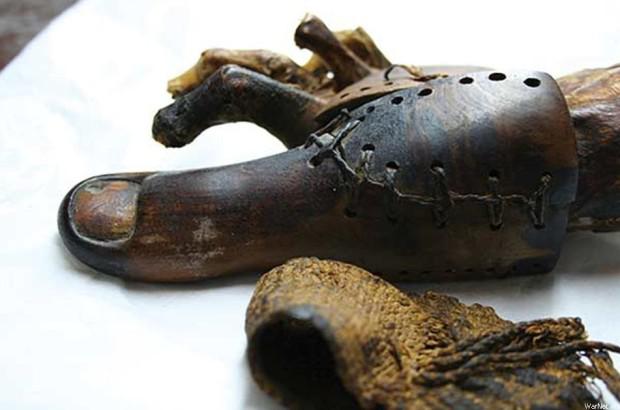
Prosthetic limbs - a hope for many people with disabilities from around the world. Thanks to them, people can once again gain the ability to walk and even run. Dentures look like things that could appear only in the XX-th century, but do not let today's complex mechanisms and materials to deceive you: dentures were used before the birth of Christ.
Archaeologists have found a solid object, dating to the fifth Egyptian dynasty (2750-2625 gg. BC. E.) That could support the broken bones. Also in 1858, researchers discovered a prosthesis made of wood and copper in Capri, Italy, dating from 300, the year BC. e. Of course, these primitive prosthetic leg were not as convenient and efficient as modern, but it is for those times was no small achievement.

The actual development of artificial limbs started when French surgeon Ambroise Pare began practicing amputation, that soon began to do everywhere. Since then, a host of advances in prosthetics. For example, in 1863, the year Parmile Dubois came up with an improved design of the prosthesis - now he was connected to the limb, taking into account the atmospheric pressure. In 1898, the year Dr. Vangetti invented prostheses that are controlled by muscle contraction.
2. Prezervativy
Condoms allow people to have sex without the fear of contracting sexually transmitted disease or become pregnant. Some community groups like the Catholic Church oppose the use of condoms, but it is undeniable that they have helped to save thousands, if not millions of lives around the world.
AIDS community and the government have learned in the 1980s, and has since gained wide popularity condoms. But they were invented much earlier - they were an integral part of ancient civilizations as early as the 1000-ies BC. e.

Of course, if they are not made of latex or polyurethane, and leather, silk oiled paper or thin hollow horn or animal intestines, and is often used as long as they are not fully triturated. That was until the XV-th century, when Italian doctor Gabriel Fallopian not suggested using condoms disposable linen sheaths to protect against syphilis.
3. Tualety
Can you imagine a world without toilets? World war, chaos and death, where there is not even a place to sit quietly and read your favorite book? Toilets have made our lives convenient, comfortable and civilized.

Modern toilets were first presented to the public in 1800, the year. Their invention is credited to Thomas Krepperu, but it is not so. In fact, the toilets invented godson of Queen Elizabeth I, Sir John Harrington - he invented the first flush toilets in 1596, the year. However, his invention was then used only in the royal houses, and modern toilet Krepper made public, so many people consider him the inventor.
However, the toilets were mankind for thousands of years. Experts have found that some civilizations used the toilets intended back in 3000 years BC. e. For example, in people's homes Harappan civilization they were, and that was not a luxury but a subject for everyday use.
4. Dressing bumaga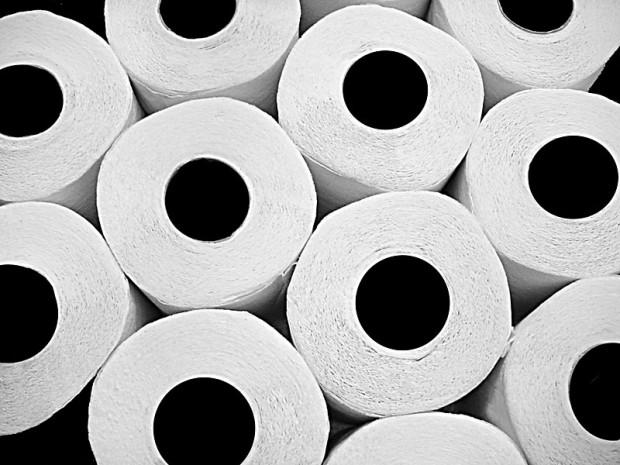
No talk about toilets should not be considered complete without a mention of toilet paper. This is a simple but highly necessary invention appeared in Britain and America in the 1800s, but has become popular among the people only in the 1900s, when general widely toilet cubicles - separate rooms.
But as our ancestors before the toilet paper has become commercially available? Yes, everything in sight - wood chips, sand, leaves, algae, moss, grass, ferns, shells, apple peel, wool, hemp, lace and stones even in case of emergency.
But one civilization was the cleverest: Chinese began to use more toilet paper in the VI century BC. e. However, it is important to note that the toilet paper is mainly used in the imperial palace in China and some wealthy Chinese families. Ordinary Chinese are treated to all the above, but not for long - soon toilet paper in China has become available and the poor. In XIV-century merchants from Zhejiang province producing 10 million packages of toilet paper per year.
5. Batarei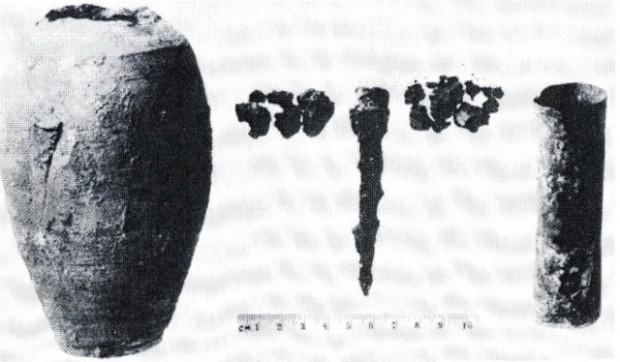
The inventor of the first modern battery is considered to Alessandro Volta: in 1800, he created the copper and zinc plates the first "voltaic pile". Even before Volta, in the 1700s, scientists conducted experiments on the production and storage of electricity, but they were unsuccessful. But Volta managed to create a device that could produce electricity through chemical reactions.
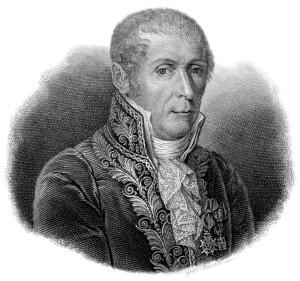
But even before the Volta and his predecessors came to a head even thinking about batteries, their very effectively used by the ancient people. The first batteries are considered the inventors of the Parthians - tribe, prosperous 250-x in Godot. BC. e. on the territory of present-day Iraq.
In contrast to the Volta, the Parthians did not use copper and zinc plates - instead they were clay pots filled with vinegar. Inside were an iron rod and a copper cylinder. Obviously, compared to the "voltaic pile" battery Parthians was very primitive, but at that time, and it was a breakthrough.
6. Hromirovanie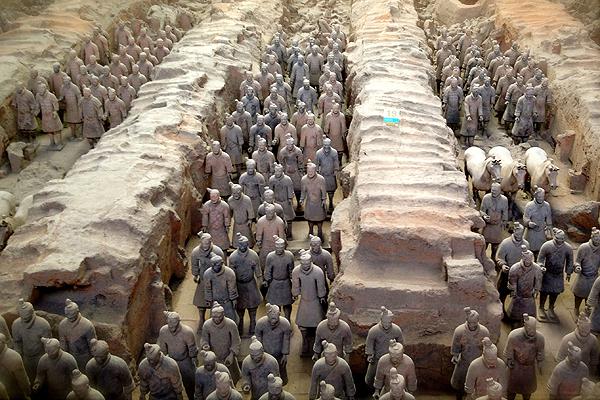
People use chrome for many purposes - for example, to make the surface harder and more durable to provide corrosion resistance and do maintenance and prevention devices easier. Chrome plating technology seems to be relatively new - American Colin Fink Garfield patented invention only in 1926. There is also a German patent for chrome, issued in 1924 by E. Librihu.
However, in 1974, the discovery of the tomb of Qin Shi Huang Di in Shaanxi, China, proved that chrome is not a modern marvel. It turns out that the ancient Chinese chromed their weapons more than 2,000 years ago. When archaeologists discovered the tomb of Huang Di, they were amazed - it was the biggest collection of terracotta statues in the world, as well as a variety of weapons: arrowheads, battle axes, crossbows and spears. All these items have survived thanks to the chrome-plating technology.
7. breath fresheners and toothpaste
It seems that the oral hygiene - a relatively new trend, but before that nobody cared. At least a few hundred years ago, something for sure. It is not so: the ancient Egyptians brushed their teeth more thousand years ago.
The Egyptians were very scrupulous regarding the oral hygiene, especially because many of them suffer from oral diseases. To hide halitosis, Egyptians invented the first breath fresheners - if they consisted of myrrh, cinnamon and incense. These fragrant spices boiled with honey and rolled into small balls.
Of course, the Egyptians understood that health alone is not enough honey candy, and invented the first toothpaste. It was not such a pleasant and sophisticated as modern pasta, but did their job. Egyptian version consisted of bovine hooves, pumice, ash and zhzhёnoy eggshells - it is, in case you want to feel like an ancient Egyptian.
8. Plastic hirurgiya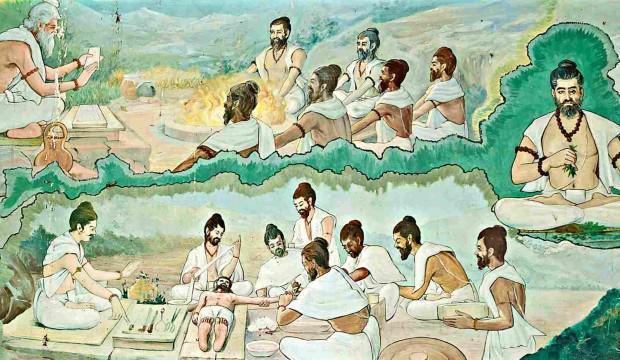
Nowadays, many people resort to plastic surgery as long as possible to remain attractive. If we consider what modern technology necessary to carry out this complex medical procedure, it is easy to assume that plastic surgery is a relatively new field. But this is not true: in eight eyelid. BC. e. Hindu doctors have already performed and continuously improve these delicate operations.
However, they did their very practical reasons, aesthetics there was nothing to do. In Indian culture, the nose was considered a symbol of pride, and during the war the enemy is often labeled in this sensitive part of the body. In addition, the Indians often were punished criminals, disfiguring, if not cutting off your nose. A plastic surgeons then noses restored. They also performed surgery on damaged earlobes.
9. Trading avtomaty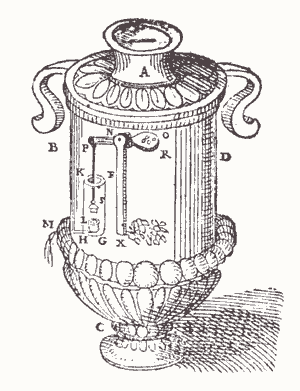
Now vending machines you can buy everything - from cigarettes to lottery tickets. They have made our lives easier and more convenient. But they can not be called modern. In fact, they have existed for thousands of years, and the first machine was invented to hold holy water.
Greek professor and inventor Hero of Alexandria, who lived in the I century BC. e., the first vending machine was invented to keep the holy water and keep it away from thieves. Yes, people have stolen holy water, because then it was in the price, and the pilgrims were willing to pay for it a lot of money. Often, they are also water from the temples and steal.
Heron invented a machine for temples, which allows you to take just the right amount of holy water, for which the pilgrims had already paid. The design of the vending machine Heron was very simple, but to stop the theft of the car in the temple helped.
10. Falloimitatory
Of course, dildos are not as necessary as toilets, and are not so revolutionary invention as batteries, but they are to a large extent brightens the life of couples or single people. In addition, they are humanity is much longer than the rest of the items on our list.
In 2005, the year in a German cave was found the oldest known dildo in the world. It is made of stone, with a length of 20 cm, and width - 3 cm. According to experts, it is about 28 000 years.
In 2010, the year in Sweden was found another dildo, but he was "just something" six to eight thousand years. Swede old version is made of wood and is much less - 10, 5 cm in length and 2 cm in width.
Some experts suggest that the dildos were used not only for sexual purposes, but also as tools such as a hammer. In addition, archaeologists are not sure whether to use dildos in ancient times by appointment only women or men, too fond of it. Well, that's that, we probably will not ever know.
via factroom.ru
1. Protezy

Prosthetic limbs - a hope for many people with disabilities from around the world. Thanks to them, people can once again gain the ability to walk and even run. Dentures look like things that could appear only in the XX-th century, but do not let today's complex mechanisms and materials to deceive you: dentures were used before the birth of Christ.
Archaeologists have found a solid object, dating to the fifth Egyptian dynasty (2750-2625 gg. BC. E.) That could support the broken bones. Also in 1858, researchers discovered a prosthesis made of wood and copper in Capri, Italy, dating from 300, the year BC. e. Of course, these primitive prosthetic leg were not as convenient and efficient as modern, but it is for those times was no small achievement.

The actual development of artificial limbs started when French surgeon Ambroise Pare began practicing amputation, that soon began to do everywhere. Since then, a host of advances in prosthetics. For example, in 1863, the year Parmile Dubois came up with an improved design of the prosthesis - now he was connected to the limb, taking into account the atmospheric pressure. In 1898, the year Dr. Vangetti invented prostheses that are controlled by muscle contraction.
2. Prezervativy

Condoms allow people to have sex without the fear of contracting sexually transmitted disease or become pregnant. Some community groups like the Catholic Church oppose the use of condoms, but it is undeniable that they have helped to save thousands, if not millions of lives around the world.
AIDS community and the government have learned in the 1980s, and has since gained wide popularity condoms. But they were invented much earlier - they were an integral part of ancient civilizations as early as the 1000-ies BC. e.

Of course, if they are not made of latex or polyurethane, and leather, silk oiled paper or thin hollow horn or animal intestines, and is often used as long as they are not fully triturated. That was until the XV-th century, when Italian doctor Gabriel Fallopian not suggested using condoms disposable linen sheaths to protect against syphilis.
3. Tualety

Can you imagine a world without toilets? World war, chaos and death, where there is not even a place to sit quietly and read your favorite book? Toilets have made our lives convenient, comfortable and civilized.

Modern toilets were first presented to the public in 1800, the year. Their invention is credited to Thomas Krepperu, but it is not so. In fact, the toilets invented godson of Queen Elizabeth I, Sir John Harrington - he invented the first flush toilets in 1596, the year. However, his invention was then used only in the royal houses, and modern toilet Krepper made public, so many people consider him the inventor.
However, the toilets were mankind for thousands of years. Experts have found that some civilizations used the toilets intended back in 3000 years BC. e. For example, in people's homes Harappan civilization they were, and that was not a luxury but a subject for everyday use.
4. Dressing bumaga

No talk about toilets should not be considered complete without a mention of toilet paper. This is a simple but highly necessary invention appeared in Britain and America in the 1800s, but has become popular among the people only in the 1900s, when general widely toilet cubicles - separate rooms.
But as our ancestors before the toilet paper has become commercially available? Yes, everything in sight - wood chips, sand, leaves, algae, moss, grass, ferns, shells, apple peel, wool, hemp, lace and stones even in case of emergency.
But one civilization was the cleverest: Chinese began to use more toilet paper in the VI century BC. e. However, it is important to note that the toilet paper is mainly used in the imperial palace in China and some wealthy Chinese families. Ordinary Chinese are treated to all the above, but not for long - soon toilet paper in China has become available and the poor. In XIV-century merchants from Zhejiang province producing 10 million packages of toilet paper per year.
5. Batarei

The inventor of the first modern battery is considered to Alessandro Volta: in 1800, he created the copper and zinc plates the first "voltaic pile". Even before Volta, in the 1700s, scientists conducted experiments on the production and storage of electricity, but they were unsuccessful. But Volta managed to create a device that could produce electricity through chemical reactions.

But even before the Volta and his predecessors came to a head even thinking about batteries, their very effectively used by the ancient people. The first batteries are considered the inventors of the Parthians - tribe, prosperous 250-x in Godot. BC. e. on the territory of present-day Iraq.
In contrast to the Volta, the Parthians did not use copper and zinc plates - instead they were clay pots filled with vinegar. Inside were an iron rod and a copper cylinder. Obviously, compared to the "voltaic pile" battery Parthians was very primitive, but at that time, and it was a breakthrough.
6. Hromirovanie

People use chrome for many purposes - for example, to make the surface harder and more durable to provide corrosion resistance and do maintenance and prevention devices easier. Chrome plating technology seems to be relatively new - American Colin Fink Garfield patented invention only in 1926. There is also a German patent for chrome, issued in 1924 by E. Librihu.
However, in 1974, the discovery of the tomb of Qin Shi Huang Di in Shaanxi, China, proved that chrome is not a modern marvel. It turns out that the ancient Chinese chromed their weapons more than 2,000 years ago. When archaeologists discovered the tomb of Huang Di, they were amazed - it was the biggest collection of terracotta statues in the world, as well as a variety of weapons: arrowheads, battle axes, crossbows and spears. All these items have survived thanks to the chrome-plating technology.
7. breath fresheners and toothpaste
It seems that the oral hygiene - a relatively new trend, but before that nobody cared. At least a few hundred years ago, something for sure. It is not so: the ancient Egyptians brushed their teeth more thousand years ago.
The Egyptians were very scrupulous regarding the oral hygiene, especially because many of them suffer from oral diseases. To hide halitosis, Egyptians invented the first breath fresheners - if they consisted of myrrh, cinnamon and incense. These fragrant spices boiled with honey and rolled into small balls.
Of course, the Egyptians understood that health alone is not enough honey candy, and invented the first toothpaste. It was not such a pleasant and sophisticated as modern pasta, but did their job. Egyptian version consisted of bovine hooves, pumice, ash and zhzhёnoy eggshells - it is, in case you want to feel like an ancient Egyptian.
8. Plastic hirurgiya

Nowadays, many people resort to plastic surgery as long as possible to remain attractive. If we consider what modern technology necessary to carry out this complex medical procedure, it is easy to assume that plastic surgery is a relatively new field. But this is not true: in eight eyelid. BC. e. Hindu doctors have already performed and continuously improve these delicate operations.
However, they did their very practical reasons, aesthetics there was nothing to do. In Indian culture, the nose was considered a symbol of pride, and during the war the enemy is often labeled in this sensitive part of the body. In addition, the Indians often were punished criminals, disfiguring, if not cutting off your nose. A plastic surgeons then noses restored. They also performed surgery on damaged earlobes.
9. Trading avtomaty

Now vending machines you can buy everything - from cigarettes to lottery tickets. They have made our lives easier and more convenient. But they can not be called modern. In fact, they have existed for thousands of years, and the first machine was invented to hold holy water.
Greek professor and inventor Hero of Alexandria, who lived in the I century BC. e., the first vending machine was invented to keep the holy water and keep it away from thieves. Yes, people have stolen holy water, because then it was in the price, and the pilgrims were willing to pay for it a lot of money. Often, they are also water from the temples and steal.
Heron invented a machine for temples, which allows you to take just the right amount of holy water, for which the pilgrims had already paid. The design of the vending machine Heron was very simple, but to stop the theft of the car in the temple helped.
10. Falloimitatory

Of course, dildos are not as necessary as toilets, and are not so revolutionary invention as batteries, but they are to a large extent brightens the life of couples or single people. In addition, they are humanity is much longer than the rest of the items on our list.
In 2005, the year in a German cave was found the oldest known dildo in the world. It is made of stone, with a length of 20 cm, and width - 3 cm. According to experts, it is about 28 000 years.
In 2010, the year in Sweden was found another dildo, but he was "just something" six to eight thousand years. Swede old version is made of wood and is much less - 10, 5 cm in length and 2 cm in width.
Some experts suggest that the dildos were used not only for sexual purposes, but also as tools such as a hammer. In addition, archaeologists are not sure whether to use dildos in ancient times by appointment only women or men, too fond of it. Well, that's that, we probably will not ever know.
via factroom.ru
Tags
See also
7 habits of creative people or how to become a creative person
Ideas that simplify your life
The most unusual bridges of the world (12 photos)
19 exciting design ideas that will save even the smallest kitchen.
11 common English idioms that are confusing foreigners. Pull your knowledge!
9 simple things that are much more complicated than they seem
11 creative ideas that significantly make life easier! Non-standard solutions of domestic problems.
13 ingenious ideas that will ensure order in the house! Something new ...
The work was halted, the inspiration is gone, ideas: 15 ways to get out of the stupor
Russell foster: Why do we sleep?

















